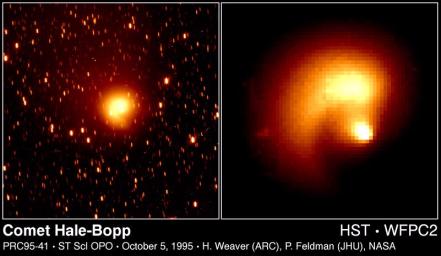
|
Hubble Sees Material Ejected From Comet Hale-Bopp
- Click the image above for a larger view
- Full-Res JPEG (800 x 465) (47.2 kB)
- Full-Res TIFF (800 x 465) (568.3 kB)
Caption:
These NASA Hubble Space Telescope pictures of comet Hale-Bopp show a remarkable "pinwheel" pattern and a blob of free-flying debris near the nucleus. The bright clump of light along the spiral (above the nucleus, which is near the center of the frame) may be a piece of the comet's icy crust that was ejected into space by a combination of ice evaporation and the comet's rotation, and which then disintegrated into a bright cloud of particles.
Although the "blob" is about 3.5 times fainter than the brightest portion at the nucleus, the lump appears brighter because it covers a larger area. The debris follows a spiral pattern outward because the solid nucleus is rotating like a lawn sprinkler, completing a single rotation about once per week.
Ground-based observations conducted over the past two months have documented at least two separate episodes of jet and pinwheel formation and fading. By coincidence, the first Hubble images of Hale-Bopp, taken on September 26, 1995, immediately followed one of these outbursts and allow researchers to examine it at unprecedented detail. For the first time they see a clear separation between the nucleus and some of the debris being shed. By putting together information from the Hubble images and those taken during the recent outburst using the 82 cm telescope of the Teide Observatory (Tenerife, Canary Islands, Spain), astronomers find that the debris is moving away from the nucleus at a speed (projected on the sky) of about 68 miles per hour (109 kilometers per hour).
The Hubble observations will be used to determine if Hale-Bopp is really a giant comet or rather a more moderate-sized object whose current activity is driven by outgassing from a very volatile ice which will "burn out" over the next year. Comet Hale-Bopp was discovered on July 23, 1995 by amateur astronomers Alan Hale and Thomas Bopp. Though this comet is still well outside the orbit of Jupiter (almost 600 million miles, or one billion kilometers from Earth) it looks surprisingly bright, fueling predictions that it could become the brightest comet of the century in early 1997.
The full-field picture on the left, taken with the Wide Field Planetary Camera 2 (in WF mode), shows the comet against a stellar backdrop in the constellation Sagittarius. The stars are streaked due to a combination of Hubble's orbital motion and its tracking of the nucleus, which is now falling toward the Sun at 33,800 miles per hour (54,000 km/hr). In the close-up picture on the right, the stars have been subtracted through image processing. Each picture element is nearly 300 miles (480 km) across at the comet's distance. In this false color scale the faintest regions are black, the brightest regions are white, and intermediate intensities are represented by different levels of red.
Even more detailed Hubble images will be taken with the Planetary Camera in late October to follow the further evolution of the spiral, look for more outbursts, place limits on the size of the nucleus, and use spectroscopy to study the enigmatic comet's chemical composition.
Background Info:
The Wide Field/Planetary Camera 2 was developed by the Jet Propulsion Laboratory and managed by the Goddard Space Flight Center for NASA's Office of Space Science.
This image and other images and data received from the Hubble Space Telescope are posted on the World Wide Web on the Space Telescope Science Institute home page at URL http://oposite.stsci.edu/ .
Cataloging Keywords:
| Name | Value | Additional Values |
|---|---|---|
| Target | C/1995 O1 (Hale-Bopp) | |
| System | ||
| Target Type | Comet | |
| Mission | Hubble Space Telescope (HST) | |
| Instrument Host | Hubble Space Telescope | |
| Host Type | Space Telescope | |
| Instrument | ||
| Detector | ||
| Extra Keywords | Color, Infrared, Rotation, Visual | |
| Acquisition Date | ||
| Release Date | 1998-08-03 | |
| Date in Caption | 1995-07-23 | 1995-09-26 |
| Image Credit | NASA/JPL/STScI | |
| Source | photojournal.jpl.nasa.gov/catalog/PIA01291 | |
| Identifier | PIA01291 | |
